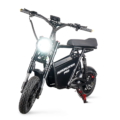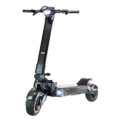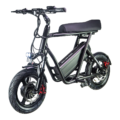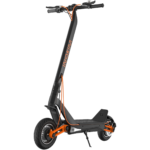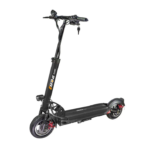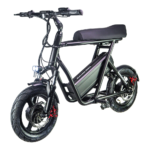- Home
- Scooters
- Electric Scooters
- EMOVE Cruiser V2 AWD
EMOVE Cruiser V2 AWD
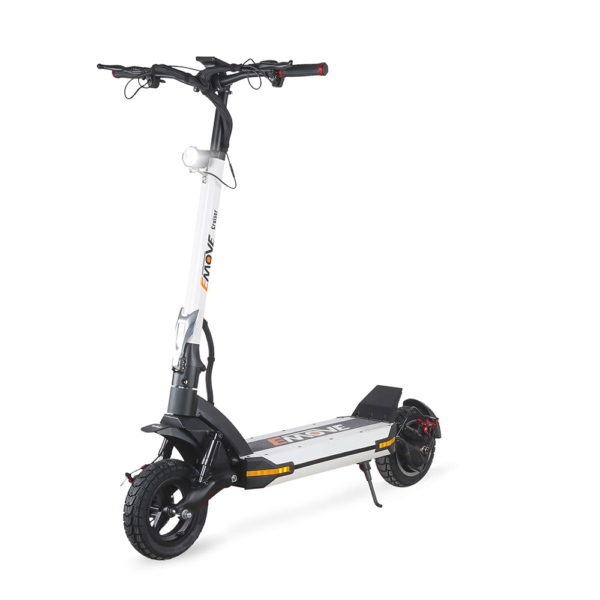

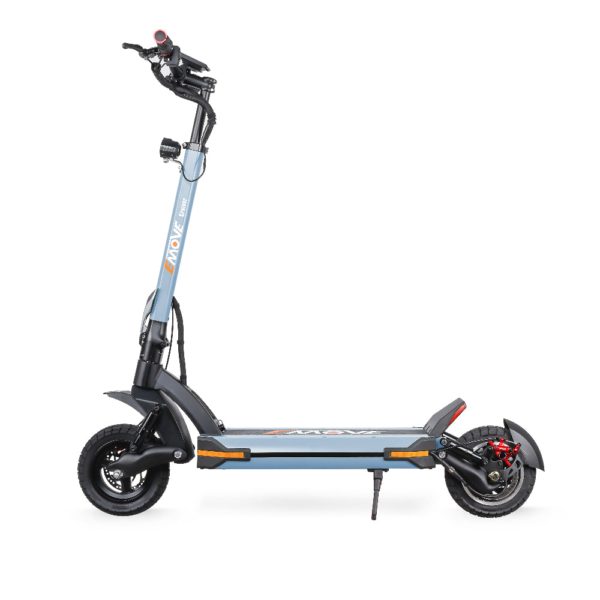
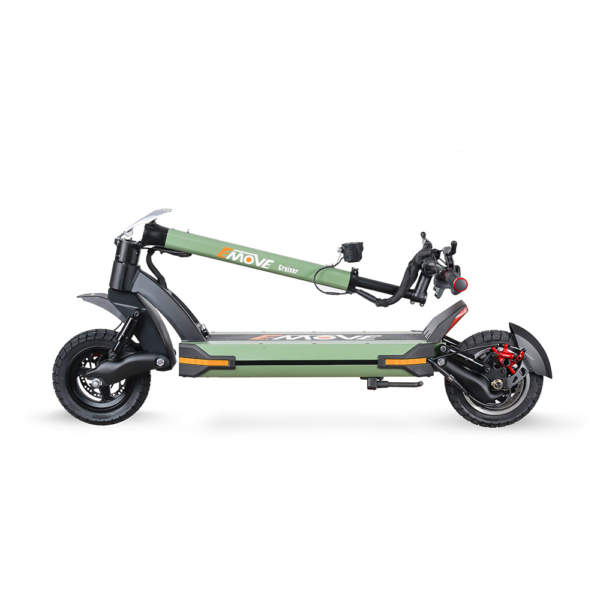
- Battery Range: 62 miles (100 km)
- Top Speed: 44 mph (70.8 km/h)
- Motor Power: 2 × 1000 W
- Weight Capacity: 330 lb (150 kg)
- Charging Time: ~9–12 h
- Scooter Weight: 85.0 lb (38.6 kg)
PROS
- Dual 1000 W motors (2WD)
- 44 mph top speed potential
- 60V 30Ah LG 21700 battery (1,800 Wh)
- IPX6 water resistance
- XTECH hybrid hydraulic disc brakes
CONS
- Very heavy at 85 lb
- Range drops at higher speeds
- No Bluetooth app
- Dimensions not specified officially
Key Takeaways
- The EMOVE Cruiser V2 AWD features dual motors for improved traction and a claimed range of 62 miles.
- It includes hydraulic disc brakes, a sinewave controller for smooth acceleration, and a 60V battery for extended use.
- The design emphasizes durability, with a sturdy frame and maintenance-friendly components like tubeless tires and sealed connectors.
- Performance is reliable for daily use, handling hills and varied terrain with ease, making it ideal for commuters and weekend riders.
- Charging takes 9-12 hours, and users should maintain tire pressure for optimal performance in different weather conditions.
Table of contents
- What Is the EMOVE Cruiser V2 AWD?
- How the EMOVE Cruiser V2 AWD Works
- Key Specifications
- Design & Build Quality
- Performance Fundamentals
- Battery, Range & Efficiency
- Ride Quality & Comfort
- Braking & Safety Features
- Portability & Daily Usability
- Maintenance & Care
- Weather & Seasonal Considerations
- EMOVE Cruiser V2 AWD vs Alternatives
- Who the EMOVE Cruiser V2 AWD Is (and Isn’t) For
- FAQs
- Glossary
The EMOVE Cruiser V2 AWD is a dual-motor, all-wheel-drive scooter made for real daily riding. It favors steady power, simple controls, and practical range. So it works for commuting, weekend loops, and heavier riders without drama. And because the platform is proven, setup and service stay simple from day one. If you’re cross-shopping trims, the single-motor sibling, the EMOVE Cruiser V2, keeps weight down and still covers long rides.
What Is the EMOVE Cruiser V2 AWD?
This version adds a front hub motor and runs a 60-volt system. So both wheels pull, and traction improves on dust and light rain. The chassis keeps a wide deck, tall adjustable bars, and quad suspension. You get hydraulic disc brakes, tubeless 10-inch tires, and a bright 3.5-inch color display. Out of the box, speed is limited for safety, and higher speeds unlock in the menu. Claimed range is about 62 miles (100 km) with a light rider at a steady city pace.
How the EMOVE Cruiser V2 AWD Works
Think of the power stack in three parts: motors, controller, and battery. Then add the controls and brakes on top.
- Motors. A rear hub motor and a front hub motor drive the wheels directly. So there is no chain to adjust or lube. AWD traction helps on loose grit and slick patches. The listed “out of box” rating is 800 W, and the menu exposes per-motor amp limits.
- Controller. A sinewave controller smooths throttle response. Starts feel clean, and the scooter creeps predictably in tight spaces. The configuration menu lets you set front and rear motor current, electronic braking strength, and gear-based speed caps. And you can keep a tame profile for paths while saving a stronger one for open streets.
- Battery. The 60 V, 30 Ah LG 21700 pack feeds both motors. That equals roughly 1,800 Wh, which helps the Cruiser hold speed on long rides without early voltage drop. Charging uses a 60 V, 2 A brick to 67.2 V full, and a cycle takes about 9–12 hours. Then let it cool before storage.
- Throttle and display. The vertical thumb throttle is easy to modulate over bumps. Plus, the 3.5-inch color display stays readable in daylight and lets you toggle units, gear limits, and advanced options. Cruise control sits in the A-settings and engages after you hold a steady speed for a few seconds.
- Brakes. Two hydraulic disc brakes with 140 mm rotors give a firm lever feel and short stops with modest hand effort. And if you want extra drag off-throttle, raise EABS strength in the menu.
Key Specifications
The table below pulls official data for planning and quick comparison. It includes folded and unfolded dimensions, so storage is easier to plan.
| Block | Details |
|---|---|
| General | Model: EMOVE Cruiser V2 AWD (dual-motor) Colors: Black, Army Green, White, Orange (availability varies) Display: 3.5-in color LCD |
| Performance & Power | Drivetrain: all-wheel drive (front + rear hub motors) Motors: 800 W listed “out of box” (per unit menus) Top speed: 15 mph (25 km/h) limited out of box; up to a claimed 44 mph (71 km/h) when unlocked on the 60 V dual-motor version Hill climb: listed 35° capability (lab claim) |
| Battery, Charging & Electrical | Battery: 60 V 30 Ah LG 21700 cells (~1,800 Wh) Charger: 60 V 2 A to 67.2 V full Charge time: ~9–12 hours Controller: sinewave control with per-motor current limits (menu E4/E5) |
| Build & Dimensions | Tires: 10 × 3 in tubeless with sealant Suspension: front and rear air shocks (quad layout on V2 chassis) Unfolded: ~50 × 27.75 × 42 in (127 × 70.5 × 106.7 cm) Folded: ~51 × 22 × 24 in (130 × 56 × 60 cm) Handlebar clamp: 31.8 mm; width ~700 mm (27.6 in) |
| Safety & Control | Brakes: dual hydraulic discs, 140 mm rotors; brake-sensored levers Lighting: headlight with horn, rear brake light, rear turn signals EABS: adjustable in menu Water resistance: IPX6 |
| Features & Extras | Cruise Control: on/off in A-settings; engages after ~5–10 seconds at steady speed Adjustable handlebar height Self-locking folding system with safety button and latch Optional seat; swappable grips/handlebars; plug-and-play parts |
| Warranty & Compliance | Warranty: 1 year standard; weight limit 352 lb (160 kg); vehicle weight ~88 lb (40 kg) |
Specs and equipment can vary by batch. Its specifications favor durability and all-weather use.
Design & Build Quality
The frame is thick welded alloy with a focus on stiffness. The deck is long and wide, so you can stand heel-to-toe or side-by-side without hanging your toes off the edge. The tubeless tires mount to split rims, which makes puncture repair and tire swaps easier at home. The looms use sealed connectors, so you can swap a throttle or light without cutting and splicing. These build specifications help with long-term ownership and quick service.
The stem locks with a self-latching system. You press a silver button, pull the latch, then lower or raise the stem. It clicks when seated, and the mechanism lands securely with a quick tug test. The handlebar uses a 31.8 mm clamp, which matches common MTB bars. So swapping to a wider bar or a different sweep is simple if you want a custom fit.
Fit and finish match the Cruiser line’s reputation. Fasteners sit flush, cable routing looks tidy, and the kickstand holds the weight without wobble. The deck surface grips your shoes in rain or heat. And the rear fender includes a clean channel for motor leads to avoid rub points.
Performance Fundamentals
Off the line, the Cruiser V2 AWD steps out cleanly. The sinewave controller smooths the first quarter turn of throttle, so starts feel controlled rather than jerky. In traffic, that matters, and it lowers stress at busy intersections.
On a flat path, a steady thumb holds speed without hunting. If you enable cruise control in the A-menu, it locks after a short hold and frees your hand on longer straights. Then a light tap on the brake or throttle cancels it. You can add more or less electronic braking in the E-menu to match your comfort on descents.
How does it climb? On 7–10% city grades, the AWD pull and deep battery keep speed better than rear-drive commuter models, especially with heavier riders. You still slow on very long ramps, but you do not bog suddenly. The listed 35° figure is a lab claim. City streets rarely exceed 10–12% for long stretches, and that range is the fair lens for daily hills. The performance specifications feel honest once you factor in rider weight and wind.
Battery, Range & Efficiency
Range depends on speed, rider weight, wind, temperature, and hills. The headline figure is 62 miles (100 km) with a 170 lb (77 kg) rider at a modest pace. In real use, you will see less if you cruise fast or climb often. And you will see more if you hold 15–20 mph with smooth starts.
The 60 V, 30 Ah pack uses LG 21700 cells and sits in the deck. So the center of gravity stays low, and stability improves at speed. The pack feeds both motors through the sinewave controller, and voltage drop stays gradual across the ride. Plan 9–12 hours for a full charge with the 2 A charger. Then unplug at green to avoid heat soak after it tops off.
Charging habits that help:
- Let the pack cool to room temp before charging on hot days.
- Charge to full for long rides and deeper weekend trips.
- For short daily rides, top to ~90–100% when you need full range.
- Store near 50–70% if you will not ride for a week or longer.
Ride Quality & Comfort
The suspension uses air shocks at both ends in a quad layout. Small chatter gets filtered without a harsh rebound kick. On cracked asphalt at 18–22 mph, the deck stays calm, and the tubeless tires add sidewall give that solid tires cannot match. For balance, run about 42 psi in cold weather and near 45 psi in heat.
The tall, adjustable bar helps taller riders stand straight. And the wide 700 mm handlebar gives stable steering with a light touch. Stem flex stays minor at city speeds. The self-locking hinge keeps the front end quiet over brick or curb cuts. If you want more leverage, a slightly wider bar improves slow-speed steering.
Braking & Safety Features
Two hydraulic disc brakes handle the main stopping work. The lever bite comes in the first half pull and ramps predictably on dry rotors. If you want more off-throttle drag, bump EABS up a level in the menu. If your route is slick in winter, drop tire pressure a few psi for a larger contact patch. You get a bright headlight with a built-in horn, a rear brake light, and rear turn signals. And the IPX6 rating covers spray and heavy rain, not standing water. So dry the scooter after wet rides and store it inside.
Portability & Daily Usability
This is a large scooter, and the listed weight sits near 88 lb (40 kg) for the AWD version. That is fine for rolling into an elevator, but it is a handful on stairs. The folded size is about 51 × 22 × 24 in (130 × 56 × 60 cm), so it fits in a hatchback or a hallway with room to pass. The folding sequence is quick once learned: press the silver button, pull the latch, lower, then lock. Always listen for the click, and tug the bar to confirm before you lift.
For security, bring a quality U-lock for the deck cutout and a cable for the front wheel if you park outside. Do not store it dripping wet, and do not leave it on a public charger. Set one speed limit for paths and one for streets. Then switch modes as you change routes without digging through layers of menus.
Maintenance & Care
A simple schedule keeps this scooter tight and quiet. It saves money over time, too.
- Before each ride: check tire pressure, spin the wheels to hear rub, and squeeze both levers. Then inspect the folding latch and confirm the lock.
- Every month: torque-check the axle nuts and the stem clamp bolts. Inspect brake pads and rotors for glaze. Top off sealant if you picked up a slow leak.
- Every 3 months: clean and lube the brake lever pivots. Next, check the harness connectors for dust, and clear any grit around the display buttons.
- Tires: when you change a tire, the split rim design simplifies the job. Depressurize, split the halves, then mind the seal so you do not nick it during reassembly.
Firmware settings live in three buckets: P, E, and A. P covers basics like units and auto-off. E sets per-gear motor current and EABS. And A holds system items like voltage, wheel size, ABS toggle, zero start, and cruise control. First, take a photo of your stock values. Then you can roll back if needed.
Weather & Seasonal Considerations
Rain riding is possible, and the sealed connectors help. Even so, slow down on paint and steel plates in the wet, and keep your throttle steady mid-turn. In summer heat, park the scooter out of direct sun, and avoid charging a pack that is still hot from a fast ride. In winter, range drops as the cells cool. So set cruise at a modest speed and keep your hands warm for lever feel. After rain, finish with a few gentle stops to dry the rotors.
EMOVE Cruiser V2 AWD vs Alternatives
Where does this scooter shine? It works as a “one and done” city machine. The large pack cuts charging stops, AWD pull helps on sandy patches, and hydraulic brakes keep stops short with less hand force. Against pure commuter models, it offers more hill headroom and better support for heavier riders. Against extreme performance models, it gives a calmer ride and less upkeep with a size that fits city storage. So it lands in a practical middle zone. If you prefer a different flavor in the cruiser class, the MotoTec Cruiser belongs on your short list.
If you ride mixed terrain and want real range at sane speeds, the Cruiser V2 AWD makes sense. If you carry up two flights daily, a lighter single-motor machine fits better. And if you chase top-speed runs on private roads, a bigger high-power platform wins on paper, though it will cost room at home and effort on every carry.
Who the EMOVE Cruiser V2 AWD Is (and Isn’t) For
- Great for: daily commuters, students who need all-weather reliability, riders near hilly districts, and anyone who values long battery life over peak numbers.
- Works well for: mixed city rides with short dirt connectors, weekend path loops, and long flat commutes where cruise control saves your thumb.
- Not ideal for: frequent stair carries, ultra-compact storage, or riders who want sharp suspension tuning for off-road jumps.
Do you want a scooter you can ride four to five times a week with minimal fuss? If yes, this AWD Cruiser fits that job, and it has headroom for bigger riders and longer routes. The trade-off is weight, so plan where you will park it before you buy.
FAQs
1) How fast is it out of the box, and what is the max when unlocked?
It ships limited to about 15 mph (25 km/h). When you unlock speed in the A-menu, the 60 V dual-motor version is listed up to 44 mph (71 km/h). Ride within local rules.
2) What is the real-world range?
The claim is 62 miles (100 km) with a 170 lb rider at a modest pace. In city use with lights, stops, wind, and hills, expect less. So plan by time, not just miles, and charge when the gauge nears two bars.
3) Does it have cruise control?
Yes. Turn A8 to ON in the A-settings. Hold a steady speed for several seconds and it locks. Then tap the brake or throttle to cancel.
4) What is the water rating?
IPX6. That covers heavy rain and spray, not submersion. So dry the scooter after wet rides.
5) How big is it when folded, and will it fit in a small SUV?
Folded size is roughly 51 × 22 × 24 in (130 × 56 × 60 cm). It fits in most hatchbacks and small SUVs with the rear seats down. Measure your cargo opening to be sure.
6) What tire pressure should I run?
A good starting point is about 42 psi in cold weather and near 45 psi in hot weather. Then adjust a few psi for rider weight and surface.
7) Where can I find an “EMOVE Cruiser V2 AWD overview” inside the display menus?
Use the P, E, and A menus on the 3.5-inch display. P covers basics, E covers per-gear motor and EABS settings, and A includes items like voltage and cruise control. First, take a photo of defaults so you can revert later.
Glossary
- Ah (amp-hours): battery capacity multiplied by voltage to estimate Wh.
- Wh (watt-hours): energy stored; higher means more potential range.
- All-wheel drive (AWD): both wheels are powered for better traction.
- Controller: the unit that meters battery power to the motors.
- Sinewave controller: smoother throttle feel and quieter motor whine.
- EABS: electronic assist that adds drag when you release the throttle.
- Cruise control: holds speed after a steady throttle for several seconds.
- Stem flex: slight movement in the steering column under load.
- IP rating: ingress protection against water and dust.
- Tubeless tire: no inner tube; uses sealant and a tight rim seal.
- Split rim: two-piece rim you can open to swap a tire.
- Sealed connector: weather-resistant plug used for scooter accessories.
- Kick start / zero start: whether the scooter needs a push to engage the motor.
- Gear limit: display setting that caps speed per gear.
- Rotor: the brake disc measured in millimeters.
Specifications
General
| Model The Model specifies the exact version or name of the scooter. It helps identify its unique design, features, and specifications within the manufacturer’s product line. Knowing the model makes it easier to compare options, find compatible accessories, or look up support information. | Cruiser V2 AWD |
| Brand The Brand identifies the manufacturer or company that designs and produces the scooter. A trusted brand is a sign of quality, reliability, and good customer support. Well-known brands often have higher standards for safety, performance, and after-sales service, giving you more confidence in your purchase. | EMOVE |
| Release Date The Release Date indicates when the scooter model was officially launched on the market. This helps you know how current the design, technology, and features are. A newer release date often means updated components, improved performance, and the latest safety or smart features. | 18 November 2025 |
| Recommended Age Recommended Age indicates the minimum age range that the scooter is designed for, based on safety, size, and ease of use. Following the recommended age helps ensure that riders can handle the scooter’s speed, weight, and controls comfortably and safely. Always check local laws and use protective gear, especially for younger riders. | +16 |
Performance & Power
| Motor Power (Wattage) What it means: The motor power, measured in watts (W), shows how strong the scooter’s electric motor is. Why it matters: Higher wattage usually means better acceleration, more torque, and improved performance on hills or rough terrain. For example, a 250W motor is good for flat city roads and light riders, while a 500W or 1000W motor provides more power for faster speeds or climbing steep inclines. | Dual hubs 2 × 1000 W |
| Top Speed The Top Speed indicates the maximum speed that the scooter can reach under optimal conditions. It’s usually measured on level ground with a fully charged battery and an average rider weight. A higher top speed allows you to travel longer distances faster, but always ensure you ride within legal speed limits and your personal comfort zone for safety. | 44 mph (70.8 km/h) |
| Battery Capacity Battery Capacity refers to the total amount of energy the scooter’s battery can store, usually measured in ampere-hours (Ah) or watt-hours (Wh). A higher battery capacity means you can ride longer distances on a single charge, reducing the need for frequent recharging. Keep in mind that actual range can vary depending on rider weight, terrain, speed, and weather conditions. | 60 V 30 Ah (1,800 Wh) |
| Estimated Range per Charge The Estimated Range per Charge indicates the average distance the scooter can travel on a single full battery charge. This range is calculated under optimal conditions, such as flat terrain, moderate speed, and average rider weight. Real-world range may vary depending on riding style, terrain, weather, and load. A longer range means fewer recharges and greater freedom for longer trips. | 62 miles (100 km) |
| Hill Climb Ability Hill Climb Ability describes the maximum incline or slope that the scooter can handle while maintaining stable performance. It’s typically expressed as a percentage or in degrees. A higher hill climb rating means the scooter can tackle steeper hills without losing too much speed or power. Actual climbing performance may vary based on rider weight, battery charge, and terrain conditions. | 20° |
| Drive System The Drive System refers to how power from the motor is delivered to the wheels. Electric scooters typically use either a hub motor (directly integrated into the wheel) or a chain/belt drive system. A high-quality drive system ensures smooth acceleration, efficient power transfer, and low maintenance. The choice of drive system affects performance, noise level, and overall ride experience. | Dual hub (2WD) |
Charging & Electrical
| Charging Time Charging Time indicates how long it takes to fully recharge the scooter’s battery from empty to 100% using the standard charger provided. Faster charging means less downtime and more time on the road. Actual charging time may vary slightly depending on battery capacity, charger output, and environmental conditions. | Approx. 9–12 hours |
| Battery Type Battery Type refers to the specific technology used in the scooter’s battery, which affects performance, lifespan, weight, and charging time. Most modern electric scooters use high-quality lithium-ion (Li-ion) batteries because they offer a good balance of energy density, durability, and low maintenance. A reliable battery type ensures consistent power delivery and longer riding ranges. | Lithium-ion pack with Smart BMS |
| Removable Battery A Removable Battery means the battery pack can be easily detached from the scooter for convenient charging and replacement. This feature allows you to charge the battery separately, swap it with a spare for extended range, or securely store it indoors in extreme weather. Removable batteries add flexibility and make it easier to keep your scooter powered up wherever you are. | Non-removable internal battery (fixed pack) |
| Regenerative Braking Regenerative Braking is an energy-saving feature that converts some of the energy normally lost during braking back into battery power. When you slow down or brake, the motor works in reverse to generate electricity, which helps extend the scooter’s range and improves overall efficiency. This system also reduces wear on traditional brake components, leading to lower maintenance over time. | Yes (via electronic brake/controller) |
| Lighting Lighting refers to the built-in front and rear lights that enhance visibility and safety when riding in low-light conditions or at night. Good lighting helps you see the road ahead and ensures that other road users can see you. Many scooters include LED headlights, taillights, and sometimes brake lights or side reflectors for added safety and compliance with local traffic regulations. | LED headlight + rear/brake + turn signals |
Build & Dimensions
| Scooter Weight Scooter Weight refers to the total weight of the scooter when fully assembled, including the battery. This affects how easy it is to carry, lift, and store the scooter when not in use. A lighter scooter is more portable and convenient for commuting, especially if you need to carry it upstairs or onto public transport. Keep in mind that a sturdy frame and quality components may add to the weight but also contribute to better durability and ride stability. | 85.0 lb (38.6 kg) |
| Maximum Rider Weight Maximum Rider Weight indicates the highest rider weight that the scooter is designed to safely support while maintaining optimal performance and stability. Staying within this limit helps ensure reliable acceleration, braking, and climbing ability, and it protects the frame, suspension, and motor from excessive strain. Exceeding the recommended limit may reduce performance and increase wear on components. | 330 lb (150 kg) |
| Deck Size Deck Size refers to the dimensions of the scooter’s standing platform. A wider and longer deck provides more foot space, allowing you to stand comfortably and adjust your stance while riding. A well-sized deck improves balance and stability, especially on longer rides or at higher speeds. Compact decks, on the other hand, help keep the scooter lightweight and portable. | Quad-suspension chassis; reinforced folding assembly |
| Handlebar Height Handlebar Height refers to the distance from the deck to the handlebars, which affects your riding posture and comfort. An appropriate handlebar height helps you maintain good balance, reduces strain on your back and arms, and makes steering more comfortable. Some scooters have adjustable handlebars to fit riders of different heights, while others have a fixed height for a streamlined design. | Adjustable (telescoping) |
| Folding Mechanism The Folding Mechanism describes how easily and securely the scooter can be folded for carrying and storage. A well-designed folding system lets you quickly collapse the scooter into a compact size, making it convenient to transport on public transit, store under a desk, or fit into a car trunk. Look for sturdy latches and safety locks to ensure the scooter stays firmly in place when folded or unfolded. | Self-locking folding mechanism |
| Dimensions Folded Dimensions indicate the size of the scooter when it’s fully folded. This measurement shows how much space the scooter will take up when stored or carried, making it easier to check if it will fit in your car trunk, under a desk, or in a closet. Compact folded dimensions are ideal for commuters who need to bring their scooter on public transport or store it in tight spaces. | Not specified |
| Material Material refers to the primary construction materials used for the scooter’s frame and key components. High-quality materials like aircraft-grade aluminum, reinforced steel, or durable composites provide strength, stability, and a lighter overall weight. A sturdy material ensures the scooter can handle daily wear and tear while maintaining safety and performance. | Aluminum alloy |
Safety & Control
| Brake Type(s) Brake Type(s) describe the braking systems the scooter uses to help you slow down or stop safely. Common brake types include mechanical brakes (like drum or disc brakes), electronic brakes, and foot brakes. Many scooters combine multiple braking systems for added safety and shorter stopping distances. The type and quality of brakes affect your control, especially when riding at higher speeds or on slopes. | Front & rear XTECH hybrid hydraulic discs + electronic brake |
| Suspension Suspension refers to the system that absorbs shocks and vibrations while riding, providing a smoother and more comfortable ride over uneven or rough surfaces. Scooters may have front suspension, rear suspension, or dual suspension for better shock absorption and stability. Good suspension helps reduce rider fatigue and improves control, especially when riding on bumpy roads or off-road paths. | Front & rear (quad spring) suspension |
| Tire Type Tire Type refers to the kind of tires the scooter uses, which directly affects ride comfort, traction, and maintenance. Common types include solid (airless) tires, pneumatic (air-filled) tires, or hybrid options. Pneumatic tires offer better shock absorption and a smoother ride on rough surfaces, while solid tires are puncture-proof and require less upkeep. The right tire type helps ensure safe handling and a comfortable ride in different conditions. | 10″ × 3″ tubeless pneumatic |
| Tire Size Tire Size indicates the diameter and width of the scooter’s tires, which affect ride comfort, stability, and how well the scooter handles different terrains. Larger tires generally offer better shock absorption and a smoother ride over bumps and rough surfaces, while smaller tires keep the scooter lighter and more portable. Choosing the right tire size helps ensure a balance between agility and comfort. | 10-inch |
| Kickstand The Kickstand is a built-in stand that allows you to park your scooter upright when it’s not in use. A sturdy kickstand keeps the scooter stable and prevents it from tipping over, protecting it from scratches and damage. It also makes storing and accessing your scooter more convenient, whether you’re at home, work, or on the go. | Side kickstand |
| Water Resistance Rating Water Resistance Rating indicates how well the scooter is protected against water and moisture, usually shown as an IP (Ingress Protection) rating. This rating helps you understand whether the scooter can handle light rain, splashes, or wet roads without damage. While most scooters are not fully waterproof, a good water resistance rating adds peace of mind when riding in changing weather conditions. Always avoid deep puddles or submerging the scooter to protect its electrical components. | IPX6 |
Features & Extras
| Display/Console The Display (or Console) shows important real-time information about your ride, helping you monitor your scooter’s status at a glance. Typical displays show speed, battery level, distance traveled, and riding mode. Some models also include additional features like Bluetooth connectivity, app integration, or backlighting for better visibility at night. A clear and easy-to-read display enhances safety and convenience on every trip. | LCD display with speed, battery, odometer |
| Ride Modes Ride Modes refer to the different speed and power settings you can choose to match your riding style or road conditions. Common modes include eco for maximum range and energy efficiency, standard for everyday balance, and sport or turbo for higher speed and stronger acceleration. Switching between ride modes allows you to customize performance, conserve battery, and ride safely in various environments. | Eco/Normal/Sport (3 modes) |
| Smart App Connectivity Smart App Connectivity lets you pair your scooter with a dedicated mobile app via Bluetooth. Using the app, you can monitor real-time ride stats like speed, battery level, and range, adjust settings such as ride modes or cruise control, lock the scooter for added security, and sometimes receive firmware updates. This feature adds convenience and allows you to personalize your riding experience right from your smartphone. | No dedicated smartphone app |
| Anti-Theft System The Anti-Theft System helps protect your scooter from unauthorized use or theft. This feature can include built-in alarms, electronic motor locks, GPS tracking, or remote locking through a mobile app. A good anti-theft system provides peace of mind when parking your scooter in public spaces, adding an extra layer of security to safeguard your investment. | Not specified |
| Cruise Control Cruise Control allows you to maintain a steady speed without continuously holding the throttle. This feature makes longer rides more comfortable by reducing hand fatigue and providing a smoother, more relaxed riding experience — especially on flat, open roads or bike lanes. For safety, cruise control can usually be easily activated or deactivated while riding. | Yes (cruise control) |
| Accessories Included Accessories Included lists the additional items that come with the scooter to enhance your riding experience and convenience. Common accessories may include a charger, kickstand, bell, lights, phone holder, or carrying strap. These extras add value by making your scooter safer, easier to use, and ready to ride straight out of the box. | Scooter, 60V charger, tools, manual |
Warranty & Compliance
| Warranty Period The Warranty Period indicates how long the manufacturer guarantees the scooter against defects in materials and workmanship under normal use. A good warranty provides peace of mind, showing the brand’s confidence in its product quality. Always check what parts are covered, such as the frame, battery, and motor, and follow the maintenance guidelines to keep your warranty valid. | 12 months (region-dependent) |
| Certifications Certifications confirm that the scooter meets specific safety, quality, and environmental standards set by recognized organizations or regulatory bodies. Common certifications may include CE, RoHS, UL, or other local compliance marks, depending on your region. These certifications ensure that the scooter is manufactured to high standards and is safe and legal to use in your country. | Local micromobility compliance (region-dependent) |


